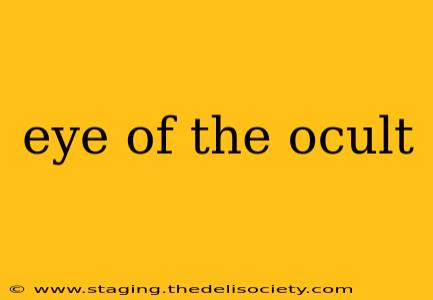The "Eye of the Occult," while not a singular, universally defined symbol, often refers to representations visually similar to the Eye of Providence—the all-seeing eye often depicted within a triangle—or other symbolic eyes found in occult traditions. These symbols, far from being monolithic, possess diverse interpretations across cultures and historical periods. This exploration delves into the multifaceted meanings and origins of eyes frequently associated with the occult.
Deconstructing the "Eye" Symbolism
The eye, across countless cultures and belief systems, represents several potent concepts:
-
Omniscience and Divine Sight: Perhaps the most prominent association is with a higher power's all-seeing nature. This is evident in the Eye of Providence, frequently interpreted as God's watchful gaze over humanity. Similar symbolism appears in ancient Egyptian mythology with the Eye of Horus, representing protection and royal power.
-
Knowledge and Enlightenment: The eye often symbolizes the acquisition of hidden knowledge and inner wisdom. In esoteric traditions, it signifies the ability to perceive beyond the veil of ordinary reality, accessing deeper truths and understanding.
-
Protection and Warding: Many cultures utilize eye-shaped amulets or talismans for protection against evil spirits or negative energies. The "evil eye" (mati) is a prime example, a potent symbol in various Mediterranean cultures believed to ward off malevolent forces.
-
Intuition and Inner Vision: The eye can also represent inner perception, intuition, and the ability to see beyond the physical realm. In some occult practices, it signifies the opening of the third eye—a mystical chakra associated with spiritual insight.
Historical and Cultural Contexts
The use of eye symbolism in occult and esoteric traditions extends across centuries and geographies:
-
Ancient Egypt: The Eye of Horus, a powerful symbol of protection and healing, played a significant role in Egyptian mythology and religious practices. Its association with healing is still relevant today.
-
Freemasonry: The Eye of Providence, frequently depicted on Masonic paraphernalia, holds varying interpretations within the fraternity, often linked to the Divine Architect of the Universe.
-
Hermeticism and Alchemy: Eye symbolism appears extensively in alchemical texts and illustrations, frequently representing the transformative process of spiritual enlightenment and the unification of opposites.
-
Modern Occultism: Various occult orders and traditions utilize eye symbolism, often with personalized interpretations within their specific frameworks. The meaning can be significantly influenced by the specific ritual or practice.
Differentiating Interpretations and Avoiding Misinformation
It's crucial to acknowledge the diverse interpretations associated with eye symbolism. Attributing a single meaning to any "Eye of the Occult" image risks oversimplification and potential misrepresentation. The context—the accompanying symbols, historical period, and the specific tradition—is vital for accurate interpretation. Misinformation often arises from conflating unrelated symbols or applying modern interpretations to ancient contexts without proper historical understanding.
Conclusion: A Symbol of Depth and Complexity
The "Eye of the Occult" encompasses a rich tapestry of meanings and interpretations, rooted in diverse historical and cultural contexts. Its power lies not in a singular definition but in its capacity to represent a multitude of concepts relating to divine power, knowledge, protection, and spiritual insight. By carefully considering the historical and cultural context of any given depiction, we can begin to unravel the intricate symbolism and appreciate the enduring fascination with the enigmatic "Eye."
